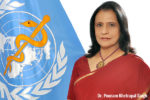Marking the World Hand Hygiene Day (May 5th, 2018), Dr Poonam Khetrapal Singh, Regional Director, WHO South-East Asia, has issued a statement that stresses on the need to promote good hand hygiene, one of the most cost-effective ways to enhance the safety and quality of healthcare facilities for all
She says, “Good hand hygiene among patients and health workers helps stop the spread of infection, control the risk of bacterial mutations and therefore antimicrobial resistance, and makes healthcare significantly more efficient.”
Emphasizing that hand hygiene is now regarded as one of the most important element of infection control activities, Dr Khetrapal said, “In particular, good hand hygiene is needed to prevent sepsis, a serious and potentially life-threatening condition that can result from the body’s response to infection. Globally, over 30 million patients are affected by sepsis every year, many of them in low- and middle-income countries. Should antimicrobial resistance advance, this number will increase. Enhanced hand hygiene in health care facilities is therefore a pressing need, and is everyone’s responsibility, from patients and health workers to administrators and policymakers.”
Dr Khetrapal listed out five key areas that demand action.
First, health workers should fully embrace the WHO-recommended ‘five moments for hand hygiene’. This five step formula requires health workers to wash their hands using an alcohol-based product for 20-30 seconds, or soap and water for 40-60 seconds, before touching a patient, before clean/aseptic procedures, after bodily fluid exposure, after touching a patient, and after touching patient surroundings.
Second, facility-based infection prevention and control leaders should seize every opportunity to champion the importance of good hand hygiene. That can – and should – include communicating the critical importance of implementing WHO guidelines on hand hygiene to policymakers, hospital chief executive officers, administrators and health workers.
Third, health facility leaders and senior management should make hand hygiene a key quality monitoring indicator. Compliance with hand hygiene standards should be a core part of every health facility’s infection control regimen, with areas of risk identified and solutions found as a matter of priority. As part of this, they should also sign up to WHO’s global SAVE LIVES: Clean Your Hands campaign, which all health facilities can be a part of.
Fourth, ministries of health from across the Region should implement the 2017 World Health Assembly resolution on sepsis, which makes improving the prevention, diagnosis and management of sepsis a critical imperative. As the resolution outlines, one of the best ways to tackle the problem is via good hand hygiene and the development of clear, country-wide guidelines on the issue.
Fifth, patient advocacy groups should continue to insist on the value of hand hygiene as a good in itself, as well as a way to drive down the occurrence of sepsis. Importantly, that means advocating for the development and implementation of effective hand hygiene-related policies, as well as good hand hygiene practices among health workers.
“From patients to health workers, administrators to policymakers, we must appreciate and understand that clean hands save lives and are one of the most powerful ways to prevent infection and sepsis. Across the WHO South-East Asia Region, promoting hand hygiene is an imperative we must all prioritize and act on decisively,” she added.
- Advertisement -



Comments are closed.